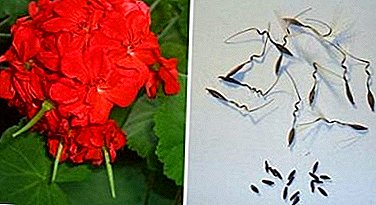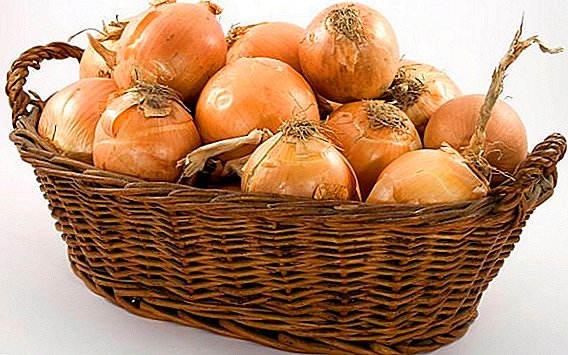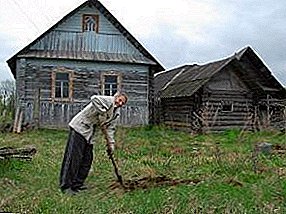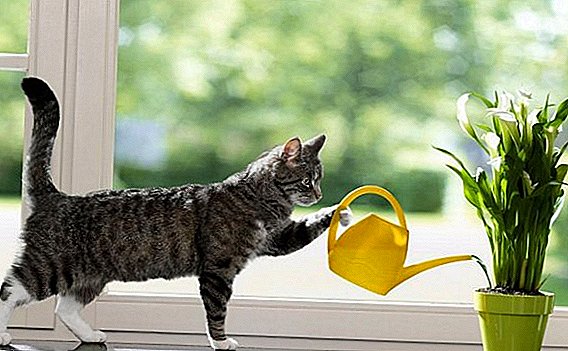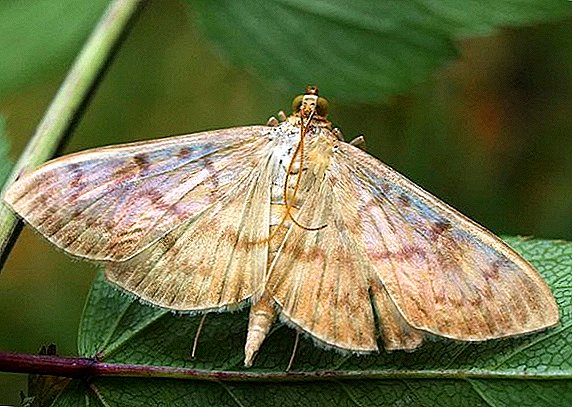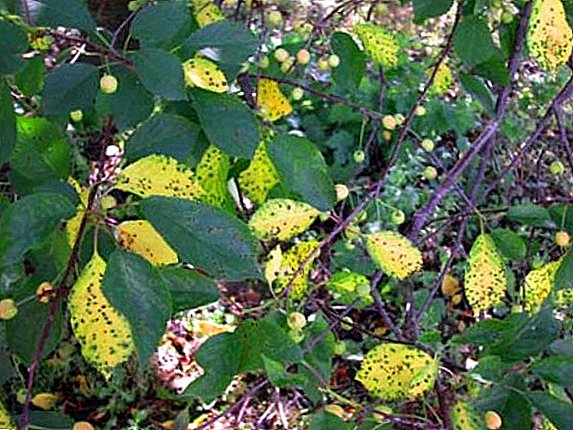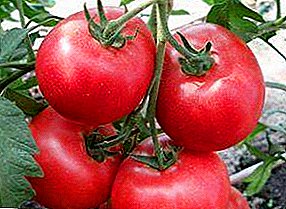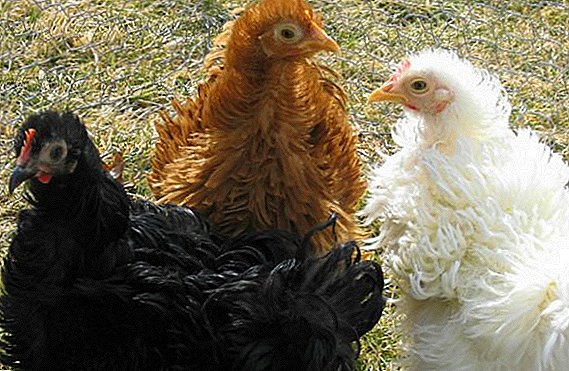 When approaching the spring harvest in many gardeners, the question arises, which varieties of vegetable crops to prefer. It is not easy to make your choice in the variety of seed that is available on the market. In this article, we will in all aspects consider one of the varieties of cucumbers called "Emerald Flow".
When approaching the spring harvest in many gardeners, the question arises, which varieties of vegetable crops to prefer. It is not easy to make your choice in the variety of seed that is available on the market. In this article, we will in all aspects consider one of the varieties of cucumbers called "Emerald Flow".
Variety description
The plant impresses with its strong stems, with medium-sized, large leaves, an abundance of ovaries and fruits growing right before your eyes. This type of cucumber culture belongs to parthenocarpic hybrids.
Did you know? Partenocarpia is the process of ovary and development of fruits without the participation of pollen. The literal translation from Greek sounds like "virgin fruit".This feature of the variety expands the possibilities of its cultivation: it is equally good for film shelters and for sowing in open ground. It develops well under adverse climatic and seasonal conditions, when the work of pollinating insects is difficult. This vegetable does not need time for seed ripening, therefore its fruits do not turn yellow, during the whole vegetative period they retain an attractive appearance and excellent taste. Presents a hybrid has a strong immunity to diseases, usually threatening cucumbers.

Find out which cucumber varieties are best suited for planting in open ground.
Fruit characteristics and yield
A representative of this variety can be called a giant, since its fruits reach an incredible size for these vegetables: length is up to half a meter, and weight is up to 250 g. From the moment of planting until the first fruits are ready to eat, it takes only 1.5 months. Cucumbers "Emerald Flow" have a thin skin with mild tubercles.
Since the seed pods are in the embryonic state, the flesh is dense, juicy, without the slightest sign of bitterness. They are suitable only for fresh use. If the rules of cultivation are observed, these vegetables will be pleased with a high yield, up to 5 kg per square meter, throughout the whole season. 
Selection of seedlings
When choosing, do not hesitate to carefully examine the proposed specimens: a good 30-day cucumber seedlings should have a strong stalk, uniformly colored dark green leaves. The height of plants at this age is 20–25 cm, and they should have 4–5 true leaves with a diameter of 15–18 cm. Such seedlings are excellent for planting in greenhouses already in mid-April, where they quickly take root and early begin to bear fruit. In case of violation of the technology of growing seedlings or when the light regime is not observed, the stems will be elongated, thin, and small leaves will have a pale appearance.
Check out the peculiarities of growing other hybrid varieties of cucumbers: "Aquarius", "Real Colonel", "Herman", "Shosh", "April", "Merengue", "Hector F1".
The root system in healthy plants should be well developed, but should not germinate en masse through the holes in the containers. This means that it is much older than it seems, which means that it will be more difficult to endure a transplant. Do not forget to smell the container with the roots, if the smell is unpleasant, then it is possible that these shoots are affected by rot.
In the middle of May, both in greenhouses and in open ground, you can also plant younger 20-day-old seedlings: it reaches a height of 16-18 cm, it has 2-3 true leaves, already quite large in diameter, up to 15 cm.  For planting in the soil at the end of May, very small seedlings of the Emerald Flow at the age of 10-12 days, with 1 real leaf, proved to be very good. They painlessly take root in the new place, develop with the right care very quickly and also delight in the excellent harvest. Thanks to this gradual planting of seedlings, you can provide yourself with fresh vegetables from late May until autumn frosts.
For planting in the soil at the end of May, very small seedlings of the Emerald Flow at the age of 10-12 days, with 1 real leaf, proved to be very good. They painlessly take root in the new place, develop with the right care very quickly and also delight in the excellent harvest. Thanks to this gradual planting of seedlings, you can provide yourself with fresh vegetables from late May until autumn frosts.
Important! Cucumbers are very susceptible to any climate change. At temperatures below +10 ° С their growth completely stops.Experts recommend paying attention to the containers in which such sprouts are sold: since the root system is still imperfect, it is better to prefer peat tablets or peat pots to avoid its damage.
 Carefully inspect the leaves from the outside, and especially from the inside for lesions by aphids and other sucking pests. At the slightest sign of "settling" from such a seedling should be abandoned.
Carefully inspect the leaves from the outside, and especially from the inside for lesions by aphids and other sucking pests. At the slightest sign of "settling" from such a seedling should be abandoned.Soil and fertilizer
Before breeding and growing such vegetables, one should determine the nature or composition of the soil of the plot set aside for this purpose.
The soil on the cucumber bed should be crumbly and moisture-consuming. It can only have a neutral or slightly alkaline reaction. To achieve the desired, you can hold certain activities either in autumn or in spring:
- during the autumn digging of the soil to a shovel depth, it is recommended to increase the fertile properties of about 5 kg of manure for each square meter, 25 g of phosphorus-potassium fertilizers;
- if there is increased acidity, then add 250 g of lime to this compound, if weak, then 100-150 g of lime is enough.
 "Problematic" soil can be corrected by conducting a series of activities:
"Problematic" soil can be corrected by conducting a series of activities:
- Sandy soil needs to be “weighted” with clay: from 1 to 3 clay buckets should be added to 1 square meter of sandstone. This measure will ensure the retention of moisture in the soil, otherwise cucumbers will not give a good harvest.
- Clay soil becomes dense and airtight when wet. For planting on such a site of cucumbers there is a need to make from 1 to 4 buckets per 1 square meter of sand and compost. The soil will become more friable and open to air exchange, moisture stagnation will be avoided.
Not always weather conditions and various subjective factors allow us to engage in the preparation of the land in the autumn period. You can do this in the spring. When digging a site for planting cucumbers, it is necessary to deposit 3 kg of humus or compost and 50 g of complex mineral fertilizers per 1 square meter.
These vegetables love well lit sunny spots. Although the Emerald Stream variety also feels great in shading, this in no way affects its yield. It is good if the bed is protected from the cold northern winds by some kind of shelter, structure, or by cultivar planted on the northern side of the site: winding beans or corn.  Table of compatibility of plants in the garden As in any other case, the observance of crop rotation, alternation of crops is recommended.
Table of compatibility of plants in the garden As in any other case, the observance of crop rotation, alternation of crops is recommended.
Find out what you can then plant in the garden.
Good neighbors:
- our cucumbers feel great on the soil where early and cauliflower, tomatoes, peas, beets, potatoes grew;
- onions and garlic as precursors are simply ideal, as they disinfect and enrich the soil with their phytoncides;
- The neighborhood of various vegetables and flowers helpers tolerate calmly
Bad neighbors:
- it is impossible to plant cucumbers after cabbage of late varieties and carrots, such an experiment is fraught with diseases and slow development;
- placing cucumbers next to the beds with potatoes is unacceptable.
Growing conditions
 Seedlings of this variety can be planted in greenhouses, subject to temperature control.
Seedlings of this variety can be planted in greenhouses, subject to temperature control.
- If the greenhouse is not equipped with additional heating, then it is necessary to focus on the degree of heating of air and soil, respectively. When the threat of recurrent cold weather passes, this is usually the period from the second decade of May, and the indoor air warms up to + 17 ... +19 degrees, and the soil is up to +15 degrees, then young plants will definitely be comfortable in such conditions.
- If the greenhouse is additionally heated, then binding to atmospheric conditions is not necessary, and the seedlings can be planted, focusing on its maturity. For a good active growing season, you can take care of lighting the room, especially if natural light is not enough. Although this type of cucumber is shade-tolerant, and, if for any reason the light regime is violated, it will not cause serious harm. But it is better for the health and growth of the plant that all norms and rules of cultivation are respected.
Proper watering of young plants lays the foundation for the future rich harvest. It is only important to observe the measure: the ground under the bushes should not be dry, cracked, or too wet, especially with stagnant water.
Get acquainted with all the subtleties of growing cucumbers in the greenhouse.
It is great if it is possible to arrange for a cucumber plantation a system of drip irrigation with water at room temperature. If this is not available, then it is sufficient to water the plants from a watering can with a spray. Since this crop gives the main growth at night, it is advisable to carry out watering in the evening, after the heat subsides, with water heated during the day.
Important! Dry ground cannot be poured in abundantly at once: drops of moisture can cause the formation of rot on roots and stems, which in itself can lead to the death of the plant.In order to choose a proper watering regime, one should pay attention to the fact that in hot weather this procedure is carried out every day, and in rainy cool weather it is watered as the soil dries.
To prevent the roots of the plants from being bare after compaction of the wet ground, it should be regularly and extremely carefully loosened. If necessary, you can pour nutrient soil mixture under the bushes. To create comfortable conditions in the greenhouse, the cucumber giant needs to regularly ventilate the room so that the greenhouse effect does not cause the development of pathogenic bacteria.
Growing from seed to seedlings at home
If you have the opportunity and desire, it is better to grow the seedlings of these amazing cucumbers on their own. In order to achieve excellent germination of vegetable crops, to provide resistance to diseases and aggressive effects of the external environment, to reward in the end their work with an impressive harvest, it is necessary to carry out a thorough preparation of seed and the plot of land allocated for vegetable growing.
Seed preparation
In specialized stores can offer a range of drugs and suspensions for the treatment of seeds and soil. In their application, two main objectives are pursued: disinfection and growth stimulation. They are solved by usual potassium permanganate and hydrogen peroxide.  The seeds of the Emerald Flow, in spite of their exoticism, will not cause any particular difficulties in the preparatory period. A careful examination of the planting material reveals whether there is a surface film on it or not. If the answer is yes, then you can not pre-cucumber seeds soaked. If there is no coverage, then such an operation cannot be avoided. Three hours is enough to keep them in the following solution: for 100 ml of water add 1 teaspoon of hydrogen peroxide.
The seeds of the Emerald Flow, in spite of their exoticism, will not cause any particular difficulties in the preparatory period. A careful examination of the planting material reveals whether there is a surface film on it or not. If the answer is yes, then you can not pre-cucumber seeds soaked. If there is no coverage, then such an operation cannot be avoided. Three hours is enough to keep them in the following solution: for 100 ml of water add 1 teaspoon of hydrogen peroxide.
Water saturated with additional oxygen stimulates the germination of grains and produces additional disinfection. After this treatment, the sowing composition is dried to flowability, if it will be sown in open ground after some time. If sowing is done on seedlings, then it is advisable to do it immediately after soaking. Hybrid seeds with the F1 mark are sold already treated and disinfected, so in this case you should be more careful in preparing the soil.
Content and location
Soil mixture for planting cucumber seeds should be light, crumbly, nutritious. If it is not possible to purchase pre-packaged land in a specialized store that fully meets these requirements, then you will have to prepare it yourself. To do this, it is enough to mix 2 parts of peat and humus with 1 part of rotted sawdust. To 10 liters of this mixture should be added to 1 cup of wood ash and 1 teaspoon of urea, superphosphate and potassium sulfate.
To improve the drainage properties, air permeability, it is recommended to add environmentally friendly materials to the seedlings soil - agroperlite or vermiculite, expanded clay or crushed foam.  Vermiculite for seedlings But in any case, before sowing the prepared seeds, it is recommended to water the soil mixture with a weak-borne solution of potassium permanganate or diluted with 3 tablespoons of hydrogen peroxide in 10 liters of water. In this way, the purity of the soil is guaranteed, and hence the protection of future seedlings from pests and annoying diseases.
Vermiculite for seedlings But in any case, before sowing the prepared seeds, it is recommended to water the soil mixture with a weak-borne solution of potassium permanganate or diluted with 3 tablespoons of hydrogen peroxide in 10 liters of water. In this way, the purity of the soil is guaranteed, and hence the protection of future seedlings from pests and annoying diseases.
To prevent injury to young cucumber sprouts during transplantation in the greenhouse or in the open ground, it is better to use peat pots or peat tablets for growing "emerald" seedlings: the plants are planted with them without unpleasant consequences, while also receiving additional healthy nutrition from decaying in moist peat ground.
To seedlings normally grow and develop, you need to take care of the correct capacity. We advise you to find out whether to grow seedlings in peat tablets.
Seed planting process
- As a result of soaking and subsequent drying, the seeds of the Emerald Stream usually begin germination.
- Carefully, in order not to damage the sprung sprout, plant one grain into prepared seedlings with moist soil to a depth of 1.5-2 cm, sprinkle with a nutritious soil mixture.
- Until the moment when sprouts appear on the surface, it is recommended to maintain the temperature in the range of +25 degrees. To achieve the greenhouse effect, you can cover the pots with glass or plastic bags.
- As soon as the cucumber sprouts become visible, the tanks should be opened and the temperature for the seedlings should be reduced to +19 degrees.

Did you know? The most important asset of cucumbers is the unique substance tartronic acid. This acid neutralizes the effect of carbohydrates that enter our body during a meal, thereby preventing the appearance of fat mass. That is why the use of cucumbers is appropriate for diet.
Seedling care
To ensure optimal growth conditions of the cucumber culture, it is necessary to put it closer to the window in order to provide a good lighting mode. If it is not possible to use window sills or there is no space around them, then you will have to install additional lighting for the seedlings. The frequency of watering depends on the rate of drying of the soil in pots. For seedlings, both a surplus of moisture and its deficiency are dangerous, because the root system is still imperfect and weak to withstand such extremes, therefore watering should be moderate and timely.  In order to prepare the seedlings for planting either in the greenhouse, or in the open ground, experts advise about 10 days before the designated operation to begin its hardening. To do this, it is necessary for a couple of hours to carry containers with planting materials to the street or to the balcony. It is desirable that at least the first sessions were conducted in calm, warm weather. If the weather is not lucky, then you can build some kind of shelter from gusts of wind or rain. On the balcony or on the terrace of the house, this issue is solved more simply: there is a shelter, and access to "street" air and temperature, too.
In order to prepare the seedlings for planting either in the greenhouse, or in the open ground, experts advise about 10 days before the designated operation to begin its hardening. To do this, it is necessary for a couple of hours to carry containers with planting materials to the street or to the balcony. It is desirable that at least the first sessions were conducted in calm, warm weather. If the weather is not lucky, then you can build some kind of shelter from gusts of wind or rain. On the balcony or on the terrace of the house, this issue is solved more simply: there is a shelter, and access to "street" air and temperature, too.
Transplanting seedlings to ground
In order for a plant planted on seedlings to quickly and painlessly take root in a permanent place, it is unacceptable to rush into a transplant without waiting for the soil to warm up to + 8 ... + 10 degrees and air to + 15 degrees. If cucumbers are planted in open ground, then you should focus on the period after the May holidays, when the threat of spring frosts is over. If this process is carried out in a greenhouse, and even in a heated one, then the binding to weather conditions is very conditional.
Important! It is impossible to keep the seedlings in pots for more than 30 days, because after this period it will be difficult to respond to different manipulations and difficult to adapt to new living conditions.
- In the leveled beds, forming rows with the help of a stretched cord, small ones are prepared, with a depth to the height of the peat tank or an earthen coma around the plant, hole. Since this hybrid is classified as medium, the distance between the holes should be no more than 30-35 cm, and between the rows of these plants with large leaves - not less than half a meter.
- When the wells are prepared, they must be poured with water, it is possible with the addition of hydrogen peroxide, if this procedure was not carried out ahead of time, at the rate of 0.8 l in each well.
- Then a pot or an earthen clod with a sprout is put there, so that their upper edges coincide with the well-hole, and sprinkle it with the prepared earthen mixture.
- After planting, cucumbers should be poured abundantly with room temperature water at the rate of 2 liters for each bush.
- To prevent drying of the soil and protection from weeds, it is better to mulch it with pine needles, or sawdust, or black agrofibre.
- In the first 3-4 days after planting, seedlings should be watered abundantly. It is advisable to do this in the evening, avoiding further water on the leaves, which can provoke the occurrence of undesirable complications in the development of the plant.
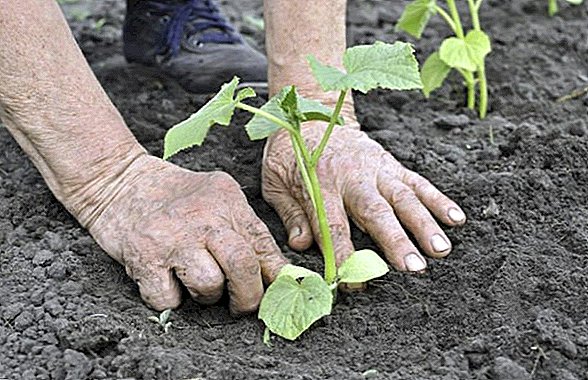
Agrotechnics growing seeds in open ground
Cucumbers variety "Emerald flow" can be called a universal variety in terms of the method of their cultivation.And seedlings, and sowing seeds in the ground, while respecting the necessary care, have proven to be resistant to diseases, intensive growth and high yields. If the above described rassadny method is unacceptable for any reason, then vegetable growers should not be upset. This variety is characterized by almost one hundred percent germination of seeds when sown in open ground.
Outdoor conditions
Despite the exotic appearance of this hybrid, it does not require any special preparatory action for planting, development and maintenance. Equally successfully, these cucumbers grow and bear fruit in greenhouses and in the open field. The main requirement for their maintenance outside the shelter concerns the temperature of the air and the ground. Usually, the seeds of this crop are sown when, during 2-3 days, the night temperature of the soil is at least +12 degrees, and the air in the daytime is, respectively, +20 degrees.
It is useful to know why cucumbers need iodine and how to properly apply it in the open field and in the greenhouse.
 If, when planting plants in greenhouses, it is possible not to be attached to climatic conditions, especially if there is additional heating, then their development and active growth in the natural environment completely depend on the average daily temperature and the degree of soil warming up. Cucumbers love well-lit places, but this hybrid is completely calm and can also actively grow in shading.
If, when planting plants in greenhouses, it is possible not to be attached to climatic conditions, especially if there is additional heating, then their development and active growth in the natural environment completely depend on the average daily temperature and the degree of soil warming up. Cucumbers love well-lit places, but this hybrid is completely calm and can also actively grow in shading.
The process of planting seeds in the ground
Sowing usually occurs in the second half of April or early May.
- In wet, but not overwetted soil, grooves are made 3 cm deep, seeds are located at a distance of 15-20 cm and carefully, so as not to damage the sprouted shoots, they are filled with nutrient mixture. Her tamping is not necessary. The distance between the rows is usually kept within 70 cm.
- To prevent drying of the soil and to protect the source material from the bear it is recommended to mulch the bed with pine needles or sawdust. To provide the most favorable conditions for growth, the sown area can be covered with film. In this way, it is also possible to protect crops from unforeseen temperature fluctuations or spring frosts.
VIDEO: CROPS OF SEEDS IN GROUND This variety belongs to high-yielding salad types and often 2-3 shrubs are enough to provide two families with fresh and tasty fruits throughout the season. So if you do not intend to sell the fruits on the market, then you should think about the need to sow a large piece of land with these exotics.
Watering
Proper watering several times increases the chances of a great harvest. After the seeds are planted in the spring, it is enough to water them once a week with water at room temperature. It is good to do it from a watering can or a hose with a spray without a strong pressure. Do not strive to fill the bed with buckets. Excessive moisture leads to compaction of the soil and can cause fungal complications. Even with the resistance of this hybrid to diseases, this situation can adversely affect their development.
Sometimes the spring months are characterized by high temperatures. It is possible to avoid drying out the soil by daily irrigation and using mulching materials. Perfectly recommended drip irrigation systems. If you can not buy an industrial version, you can make it yourself, using plastic bottles.
We recommend to learn how to make drip watering with your own hands from plastic bottles.
 Drip irrigation Cucumbers are best watered in the eveningso that the droplets of moisture on the leaves are not transformed under the influence of sunlight into lenses and do not lead to burns of green mass. In dry hot weather, to prevent overheating of the plants, it is good to water them with sprinkling. The same method avoids the erosion of the ground under the bushes. You can also make grooves between the rows and let water through them in order not to harm the roots and leaves. If the weather is rainy, the number of waterings is reduced by several times: their frequency depends only on the condition of the soil. The optimum depth of wetting should be at least 10 cm.
Drip irrigation Cucumbers are best watered in the eveningso that the droplets of moisture on the leaves are not transformed under the influence of sunlight into lenses and do not lead to burns of green mass. In dry hot weather, to prevent overheating of the plants, it is good to water them with sprinkling. The same method avoids the erosion of the ground under the bushes. You can also make grooves between the rows and let water through them in order not to harm the roots and leaves. If the weather is rainy, the number of waterings is reduced by several times: their frequency depends only on the condition of the soil. The optimum depth of wetting should be at least 10 cm.
Important! Overmoistened earth leads to the death of lateral root hairs. This weakens the plant and causes growth retardation, as well as the development of various diseases.
Soil loosening and weeding
In warm or hot weather, a dry crust quickly forms on the surface of watered soil. It interferes with proper air exchange, and cucumber roots lack oxygen. Therefore, it is necessary to carry out regular soil loosening on the cucumber bed. The root system is located very close to the surface, so it is best to restrict yourself with light scratching movements in order not to harm.  We should not carry out weeding on damp earth, because it will lead to the formation of lumps, and to the exposure of the roots. At the time of his absence at the cottage, after watering and loosening the soil, the area can be powdered with dry earth or nutrient mixture. This will prevent rapid drying of the soil.
We should not carry out weeding on damp earth, because it will lead to the formation of lumps, and to the exposure of the roots. At the time of his absence at the cottage, after watering and loosening the soil, the area can be powdered with dry earth or nutrient mixture. This will prevent rapid drying of the soil.
Simultaneously with these manipulations weeds are destroyed. You can use agrofibre or other covering material to reduce the weeds growing in the garden. The use of chemical drugs is unacceptable.
Masking
To increase the fruitfulness of this hybrid variety, it is necessary to start the formation of a shrub into one main stem with stepsons in time.
- After the appearance of the 6th true leaf, all ovaries and stepchildren, which grow in the leaf axils, are removed.
- Next, leave one ovary, tearing off the stepchildren.
- After 2-3 leaves leave the ovary and stepchild, which pinch on the first leaf, leaving it on the ovary.
 Since this is a parthenocarpic variety, the ovaries are formed in bunches, and often the plant does not have enough strength to feed them. Therefore, in order not to observe yellowing and shedding of the ovary, it is necessary to constantly carry out its partial removal. With such stimulation of the growth of lateral shoots, it is possible to significantly increase both the volume of the crop and the terms of its fruiting.
Since this is a parthenocarpic variety, the ovaries are formed in bunches, and often the plant does not have enough strength to feed them. Therefore, in order not to observe yellowing and shedding of the ovary, it is necessary to constantly carry out its partial removal. With such stimulation of the growth of lateral shoots, it is possible to significantly increase both the volume of the crop and the terms of its fruiting.
Garter
Cucumbers of the presented variety belong to medium-sized ones and need to be tied up. Often they are planted along the fence of the chain-link mesh, which becomes a natural support. It is necessary only to pass the scourge through its cells or tie it to them.
On beds or in greenhouses it is best to use stable trellis. In order not to injure the plant, it is better to install the trellis early, for example, after the appearance of 2-3 true leaves. It will provide reliable stability of the bushes, protect the fruit from pollution and deformation.
You will probably be interested to know what are the advantages of the trellis grid for cucumbers and how to install it correctly.

Top dressing
By the appearance of the plant, you can determine what nutrients it lacks:
- If the stems and leaves are pale, thin, quickly dying off, and the fruits do not correspond to the expected size, then there is not enough nitrogen in the soil.
- If the fruits are hook-shaped, and the lower leaves turn red and dry, then there is not enough potassium. Making the appropriate drugs can eliminate this drawback.
- after the appearance of the first sheet;
- after 21 days;
- before the lash comes together.
Pests, diseases and prevention
 The considered hybrid variety is resistant to diseases such as powdery mildew and cladosporiosis that is widespread among cucumbers. But preventive measures should be taken:
The considered hybrid variety is resistant to diseases such as powdery mildew and cladosporiosis that is widespread among cucumbers. But preventive measures should be taken:
- Strictly observe the temperature and irrigation regimes, loosen the soil in time, remove weeds, pour bare roots into the ground.
- The beds should initially be protected from the attack of a bear, ants. In open areas to scare away insects, you can plant marigolds and calendula, garden savory next to vegetables.
- Regularly inspect the leaves and stems, both from the outside and the inside, in time to detect the threat of infestation by aphids.
- For the treatment and prevention of fungal diseases, spray the leaves with a solution of 1 tablespoon of hydrogen peroxide and 40 drops of iodine per 10 liters of water. The plant's immunity is strengthened, oxygenation and the destruction of pathogenic organisms occur.
Harvesting and storage
The fruits of this hybrid must be harvested as they mature. It is not necessary to wait for their maximum size of 0.5 m. Very tasty, juicy and nutritious cucumbers that have reached 25-30 cm. They are not suitable for long-term storage, they quickly become soft.  This variety is well suited for salads. You can hold them for 2-3 days, if necessary, in a refrigerator in a bag. Wash them immediately before use.
This variety is well suited for salads. You can hold them for 2-3 days, if necessary, in a refrigerator in a bag. Wash them immediately before use.
Did you know? Napoleon was so honored cucumber that announced a reward to those who will be able to come up with a way to keep this vegetable fresh during the hikes. The equivalent of the award was $ 250,000, but, unfortunately, it was never received.
Possible problems and recommendations
Sometimes a problematic situation arises when leaves and fruits turn yellow and fall for no apparent reason. The main reasons for these phenomena may be:
- violation of temperature, light mode;
- lack or excess of moisture;
- lack of mineral nutrition;
- high yield of this variety.
If you want to achieve high results in classes in vegetable growing, then you should pay attention to both theoretical knowledge, and the study of the experience of other farmers, and the preparatory stage, and high-quality pre-sowing seed treatment or selection of seedlings. Your efforts will certainly be rewarded with high yields.


